Photos: Magnificent views of the nighttime heavens in America's 'Dark Sky' parks
Heavenly treasures

"The treasures hidden in the heavens are so rich that the human mind shall never be lacking in fresh nourishment," wrote 17th-century German astronomer Johannes Kepler, also a mathematician and astrologer best known for his laws of planetary motion. For Kepler and people of the 17th-century, seeing the magnificence of the star-filled night sky was ordinary.
But current estimates suggest that the Milky Way is no longer visible to one-third of modern humanity because of light pollution. That number becomes even more alarming when that one-third expands to 60% of Europeans and 80% of Americans can no longer see the Milky Way on a nightly basis. Shown here, the Milky Way spans the chasm of the Grand Canyon in northern Arizona.
"Keep your eyes on the stars, and your feet on the ground." — Theodore Roosevelt
Protecting the dark
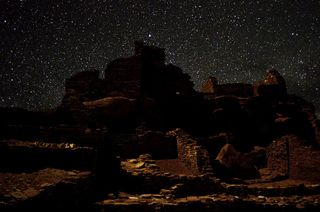
nonprofit group known as the International Dark-Sky Association (IDA) has been working since 1988 "to preserve and protect the nighttime environment and our heritage of dark skies through environmentally responsible outdoor lighting." Members of the organization have worked as advocates to protect the night sky and to educate the public, while also playing policymaker to help conserve the night sky, promote environmentally responsible outdoor lighting and empower the public to help bring back the night sky. By May 2019, IDS had declared 115 communities, parks, reserves and sanctuaries around the world with their International Dark Sky designation.
Not only does light pollution limit human enjoyment of the night sky, but research has shown it impacts the activity of phytoplankton and the egg-laying cycle of sea turtles. Shown here, the silhouette of an ancient pueblo at Wupatki National Monument near Flagstaff, Arizona, which highlights the splendor of a natural, dark sky.
"Shoot for the moon. Even if you miss, you'll land among the stars." — Les Brown (author)
Colorado Plateau

The places in the United States where the darkest skies are still found are located on the Colorado Plateau, the 240,000 square miles (386,242 km) region of the American Southwest that straddles the Four Corners area of Utah, Arizona, New Mexico and Colorado. Home to 28 national parks, national monuments and national recreation areas, the dark skies of the Colorado Plateau are as pristine as any found across America. Eight of America's national parks located on the Colorado Plateau now hold IDA Dark Sky status.
"I have loved the stars too fondly to be fearful of the night." — Sarah Williams (1837-1868)
The moral universe

Sunset Crater National Monument is found on the southern edge of the Colorado Plateau near today's Flagstaff, Arizona. The cinder cone is just one vent of the San Francisco volcanic field, a region that encompasses some 2,000 square miles (5,180 square kilometers) and contains more than 600 extinct volcanoes. The cinder cone gets its name from the reddish-brown patches of oxidized iron and sulfur found on its slopes and near the summit.
The Bonita Lava Flow is found within the national monument and is one of the largest lava flows in the region. It is a basaltic Aa flow and varies in thickness from 5 feet to over 100 feet (1.5 meters to 30 meters) and has created many lava tubes and lava ravines.
"Two things inspire me to awe — the starry heavens above and the moral universe within." — Albert Einstein
Noble stars

The night sky above Sunset Crater National Monument, shown here, is one of three International Dark Sky Parks in the Flagstaff area; Wupatki and Walnut Canyon National Monuments are the other two. In 1958, Flagstaff became the first city in the world to enact outdoor lighting restrictions in an attempt to protect the dark night sky for Lowell Observatory which is located within the city limits. In 2001 Flagstaff, Arizona was the first location in the world to receive the International Dark Sky designation by IDA. "Be humble for you are made of earth. Be noble for you are made of stars." — Serbian proverb
Looking up from Chaco
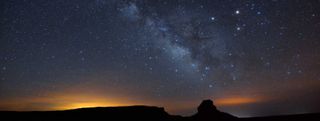
Chaco Culture National Historical Park is found in northwestern New Mexico at the southeastern edge of the Colorado Plateau. The pueblo ruins found at Chaco are the largest, best-preserved and architecturally advanced ruins of all the ancient villages of the American Southwest. The Chacoan villages were interlinked by a vast network of roads that extended for more than 100 miles (160 km). Ten major pueblo ruins are found in Chaco Canyon, and at its zenith in the ninth century, a population of 4,000 individuals lived across northern New Mexico.
The ancient Chacoans were renowned for creating early astronomical petroglyphs as well as aligning many of their pueblos with the solstice and/or equinox celestial points. Located in such a remote part of New Mexico, the night sky above Chaco has long been considered the best place in America to view the night sky. On Aug. 13, 2013 Chaco Culture National Historic Park was designated an official Dark Sky Park by IDA.
"Astronomy compels the soul to look upwards and leads us from this world to another." — Plato (427-347 B.C.)
Mighty Five

Canyonlands National Park, in southeastern Utah and near the center of the Colorado Plateau, is one of the "Mighty Five," the five awe-inspiring national parks of Utah along with Zion, Bryce, Capitol Reef and Arches. The park's magnificent geological formations — a colorful landscapes of canyons, mesas and buttes — were created by the Colorado and Green Rivers and their many tributaries. On Aug. 15, 2015, Canyonlands National Park was granted gold-tier International Dark Sky status, an honor bestowed only on such locations that have "the darkest of skies and the most stunning of starscapes."
"I believe a leaf of grass is no less than the journey- work of the stars. And the pismire is equally perfect,..." — Walt Whitman
Art gallery above us
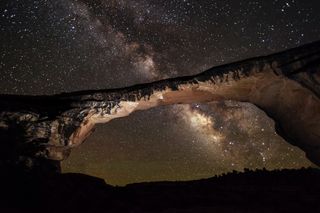
The breathtaking nighttime views of the sky above Natural Bridges National Monument are said to be of some of the darkest skies in North America. Located on the Colorado Plateau in southeastern Utah, Natural Bridges is a testament to the power of flowing water. The three huge natural bridges found here all have Hopi names: "Owachomo" meaning "rock mounts" (shown here); "Sipapu" meaning "place of emergence;" and "Kachina" meaning "dancer."
Here at Natural Bridge National Monument, visitors can see upwards of 15,000 stars compared with less than 500 visible in urban settings. So spectacular is the nighttime sky above this monument that it holds the distinction of being the first IDA-designated dark sky park in the world on March 6, 2007. Stargazers from around the world have been flocking the Natural Bridge National Monument ever since.
"The sky is the ultimate art gallery just above us." — Ralph Waldo Emerson (1803 - 1882)
Forget-me-nots of angels
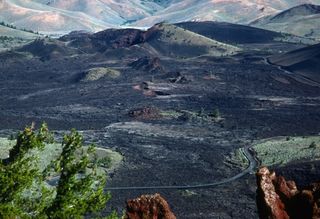
Black Canyon of the Gunnison National Park is often referred to as Colorado's Grand Canyon. The swift flowing Gunnison River drops at an average of 43 feet every mile as it rushes through the towering cliffs of Black Canyon. This drop in river elevation is six times greater than that of the Colorado River as it flows through the Grand Canyon.
Massive granite walls rise upward of 2, 700 feet (823 m) above the river and span just 40 feet (12 m) at the canyon's narrowest point. Many parts of this narrow gorge receive only 33 minutes of sunlight each day. Black Canyon of the Gunnison National Park received it official Dark Sky designation on Sept. 8, 2015. In the image, Gunnison River flows through Black Canyon with the Milky Way and a massive display of stars shining above.
"Silently, one by one, in the infinite meadows of the heaven, blossomed the lovely stars, the forget-me-nots of the angels." — Henry Wadsworth Longfellow, Evangeline, 1847
The vast Milky Way
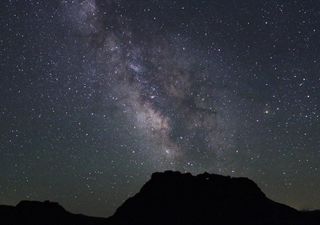
But the spectacular natural wonders of Craters of the Moon National Monument and Preserve do not end at sunset. The nighttime sky found here is stunning. Park rangers have said, "The Milky Way stretching across the park's incredibly dark night sky is a sight many visitors will never forget." The rugged wilderness of Central Idaho and the forbidding environmental conditions of the Snake River Plain have limited settlement, and will do so for years to come. Craters of the Moon National Monument and Preserve was designated a Dark Sky Park on Sept. 5, 2017.
"No one regards what is before his feet; we all gaze at the stars." — Quintus Ennius (239-169 B.C.)
Out-of-this-world skies
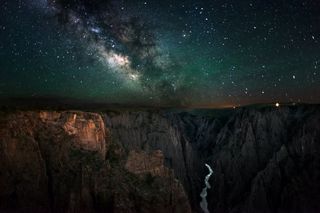
Other North American locations, not located on the Colorado Plateau, are also known for their dark, nighttime skies. Craters of the Moon National Monument and Preserve is located in central Idaho in the Snake River Plain. Its out-of-this-world landscape and dark skies are both spectacular. The landscape was formed during eight major volcanic eruptions some 15,000 and 2,000 years ago. Hot lava flowed from the Great Rift, a series of deep crevices and freely flowed to the southeast for a distance of over 52 miles (84 km). Over the years a lava field that covers 618 square miles (1,600 square km) was laid down. Craters of the Moon was designated a national monument in 1924 and is known to preserve one of the best flood basalt areas in North America.
"Ye stars! Which are the poetry of heaven!" — Lord Byron (1788-1824)
Sign up for the Live Science daily newsletter now
Get the world’s most fascinating discoveries delivered straight to your inbox.
